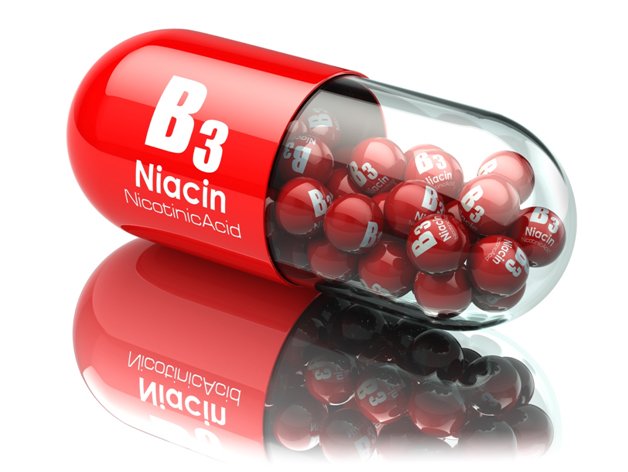Q: Why are nicotinamide and niacinamide listed as Vitamin B3 in vitamin supplements instead of niacin?
Nicotinamide, niacinamide, niacin and nicotinic acid are all names for vitamin B3. Vitamin B3 is actually two closely related compounds, niacin and niacinamide, with each version having two official names.
When vitamin B was first discovered it was thought to be only one compound, but over time 11 separate compounds were isolated and identified, often called B complex vitamins. One B-complex vitamin, vitamin B3, was originally made synthetically by adding nitric acid to nicotine, resulting in a molecule called nicotinic acid. When vitamins began to be marketed to the general public in the 1940s, the name nicotinic acid confused consumers because it was similar to nicotine, so the Food and Drug Administration (FDA) allowed nicotinic acid to have a second name: niacin.
The original name for the other form of vitamin B3 is nicotinamide, and to minimize confusion the FDA allowed it to be called niacinamide. Today, niacin and nicotinic acid are names referring to one form of vitamin B3, and its other form is called either nicotinamide or niacinamide. Vitamin formulas containing vitamin B3 may use any one of these 4 names to describe its vitamin B3 component.
Niacin and niacinamide are very similar in shape and work identically in your body to protect you from pellagra, a disease caused by a diet with inadequate amounts of vitamin B3. Pellagra became common in Asia and the United States in the early 1900s after new milling techniques created refined wheat flour and white rice. Stripping the outer husk or germ from wheat, corn and rice removed small but vital amounts of vitamins B1, B2, and B3, folic acid and iron. When the refined rice, corn products, breads and flours from this new technology became widely used, diseases from deficiencies of B vitamins like pellagra started showing up.
In the United States, pellegra was very common and caused over 7,000 deaths annually for over 2 decades, ending when vitamin B3 was added back into flour, breads cereals and corn products. Today it’s very rare to be deficient in Vitamin B3 because of the mandatory addition of B vitamins and iron to refined cereals, flours, and pastas.
Niacin and its close cousin niacinamide are identical in how they work inside your body. In fact, if you get more niacin than your body needs, your body converts the excess into niacinamide. Many multivitamin formulas use the niacinamide version of vitamin B3 instead of niacin.
Niacin has a very different effect on cholesterol and blood vessels than its close cousin niacinamide. Niacin is used therapeutically to lower triglycerides, lower LDL (the bad cholesterol) and increase HDL (good cholesterol) unlike niacinamide, which has no effect on cholesterol or triglyceride levels.
1000-2000 of niacin per day is used medically to lower LDL (“bad” cholesterol) cholesterol and increase HDL (the “good” cholesterol), while the amount in your diet needed to prevent pellagra is only 16mg of niacin equivalent (NE) for men and 14mg of NE for women. Your body can transform 60mg of tryptophan, an amino acid found in meats, to 1 mg of niacin or niacin equivalent (NE).
Niacin can cause rapid heart rate, palpitations, and hypothyroidism, while large doses of niacin can cause liver problems, trigger gout or stomach ulcers, or exacerbate asthma or gall bladder disease. Niacin can also cause insulin resistance and has been shown to increase the risk of becoming a diabetic.
The most common and annoying side effects of niacin are dose-related flushing, low blood pressure and headaches. Flushing is less of a problem with slow release niacin, but doses over 2 grams daily have been associated with liver problems. “No-flush” niacin is actually niacinamide, which has no effect on cholesterol.
Here Are 5 Key Facts About Niacin:
- Limit niacin to 2 grams per day.
To minimize the risk of liver problems, especially when using a slow-release or long-acting formula.
- Niacin can increase the effects of the blood thinner warfarin (Coumadin®).
The interaction between niacin and warfarin can potentially cause serious bleeding. To minimize bleeding risk, start niacin no more than 2 weeks before a scheduled blood test so that the dose of warfarin can be adjusted if needed.
- Avoid taking niacin with hot drinks or soup.
To minimize flushing when taking niacin, take it with food but avoid hot drinks or soup.
- Avoid large doses of tryptophan.
Because some of the tryptophan you get through your diet or supplements is converted into niacin, avoid taking large doses of tryptophan which can trigger dose-related flushing.
- Don’t waste your money on “No-Flush” niacin (niacinamide).
Niacinamide has no effect on cholesterol or triglycerides, and isn’t worth the extra cost.


